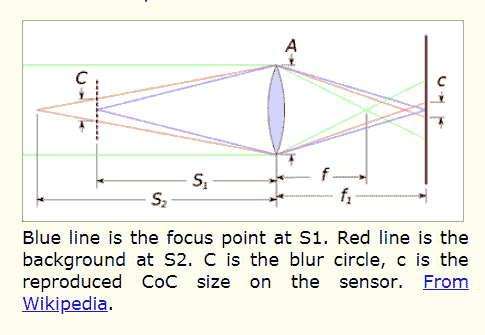WayneF
No longer a newbie, moving up!
- Joined
- Oct 11, 2013
- Messages
- 622
- Reaction score
- 114
- Location
- Texas
- Can others edit my Photos
- Photos OK to edit
@WayneF
Ok, your first post in this thread lost me. I am way to dense or you packed in to much info into a a short post. (I hope the latter more then the former).
I got lost when you jumped between the CoC and enlargement of the crop sensor. Any chance for a breakdown for dummies?
Tim
Hi Tim. I think I understand the question, but not fully sure what precise point the question is about. I do wish I knew which sentence needs clarification, but will try again as follows:
OK, just to have a number, here speaking of a full frame 35 mm film frame, with classic CoC of 0.03 mm diameter. That hypothetical 0.03mm standard is from the lens, and presumed present on the sensor image (not yet enlarged). We compute Depth of Field distance limits using that CoC diameter, and the lens parameters (focal length and aperture and focus distance), and the required sensor size enlargement to 8x10 inches (8x10 inches was just an arbitrary choice for DOF calculations many decades ago, it had to have a number too).
That 0.03mm CoC was historically tested and declared to be the maximum limit (when on the full frame sensor) of what how much out-of-focus blur diameter can still be enlarged (by our sensor size enlargement) to still be acceptable when enlarged (larger diameter should be generally perceptible to our eye, but we say our eye cannot perceive less than 0.03 mm size when it is enlarged that much).
Because when we enlarge the sensor image to print an 8x10 inch print, that enlargement also increases the blur size, and the 0.03 mm diameter limit, to something larger (this full frame enlargement is near 9x larger), which then the previous 0.03 mm becomes about the size that our normal eye vision can probably detect as blur being present. Seeing that blur becomes objectionable, which is why we defined that 0.03 mm maximum size. If we instead had a smaller sensor, then there would have been an appropriate smaller CoC. The blur can grow larger of course, further out of focus, but it becomes unacceptable if it does.
Depth of Field computes the distance limits where this viewing enlargement increases the 0.03 mm CoC limit diameter to be large enough for our eye to perceive its presence.
If the distance is within the DOF limit distances, it means the blur there is less than 0.03mm on the sensor. If outside the limits, the blur is worse. Of course, at any reasonable distance, there would really be no practical difference between one inch inside and one inch outside, it changes gradually across the boundary, but the math computes the precise hard boundary line.
I hope that was the question.
Last edited:















